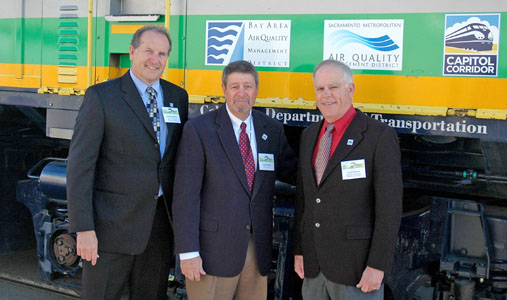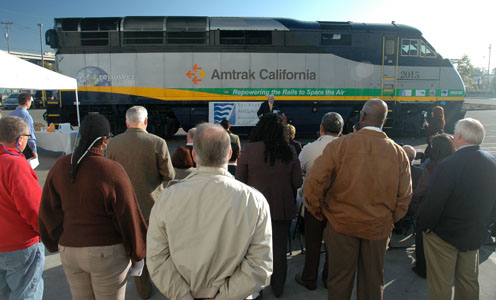Last year, the U.S. Environmental Protection Agency (EPA) tightened emission standards for diesel-powered locomotives.

Upgraded Capitol Corridor locomotives exceed newer EPA emissions standards by two levels. Each produces 45 percent less pollutants than standard locomotives. Photo by Bay Area Air Quality Management District
By Bill Picture
Published: December, 2009
“Today is a celebration of clean technology,” said BAAQMD’s Executive Officer Jack Broadbent at last month’s unveiling of Locomotive No. 2015. Broadbent estimated that putting Locomotive No. 2015 into action will eliminate 28 tons of diesel exhaust annually.
“And that means cleaner air for everyone who lives and works along the entire Capitol Corridor,” he added. “It’s an example of how key stakeholders can form partnerships that pose tangible benefits.”
Bringing trains up to greener speed
Locomotive No. 2015 was upgraded with a “Repower” kit manufactured by General Motors’ Electro-Motive Division, another partner on the project. An upgraded engine, a completely redesigned cooling system and the latest microprocessor-based locomotive control technology, along with an automatic start/stop system that eliminates unnecessary engine idling, will reduce emissions and increase fuel economy by 20 percent. Just as exciting, say the partners, is that maintaining the system is easy and affordable.
“This project is consistent with the government’s efforts to reduce carbon emissions,” said Martin Tuttle, CalTrans’ Deputy Director of Planning and Modal Programs. “These trains chug right through the middle of every city and community they serve, so they have to be safe and they have to be clean.”
Locomotive No 2015 is one of 44 trains that carry passengers along Amtrak’s Capitol Corridor and San Joaquin lines each day. Those trains are owned by CalTrans and maintained and operated by Amtrak. In 2008, the Capitol Corridor line alone carried an estimated 1.7 million passengers between San Jose and Sacramento.
“It’s the backbone of passenger train service in Northern California,” Tuttle added.
$773,323 of the $826,000 needed to pay for Locomotive No. 2015’s makeover came from BAAQMD and SMAQMD grants. The remainder came from an EPA grant. In July of this year, the BAAQMD’s Board of Directors approved the allocation of an additional $2.6 million to upgrade five more Capitol Corridor line locomotives.
The greenest way to commute
The truth is, even without Electro-Motive’s upgrade, taking the train (or any mode of public transit) is still greener than driving. A trip on the Capitol Corridor line produces one-third as much pollution as a car.
“And this retrofitted locomotive will make your trip even cleaner,” said Solano County Supervisor Jim Spering. “Automobiles are the number one source of greenhouse gas emissions in California. Since 1991, the Capitol Corridor line has prevented 196,000 tons of emissions from being released into the air—24,000 tons annually.”
As evidence, Gene Skoropowski, managing director of the Capitol Corridor Joint Powers Authority, which represents the communities along the line’s route, pointed to one Capitol Corridor passenger who, after riding the train to work for a year, was shocked when he realized he’d driven 32,000 fewer miles than the year prior.
“So, when you couple these cleaner locomotives being put into service with actual ridership, the opportunities for cleaning the air are immense,” he added.
CCJPA recently conducted a survey to find out why Capitol Corridor line passengers opted to take the train over driving. Some cited the cost of gas as a reason. Others said they preferred black fingertips from reading the newspaper during their commute to white knuckles from gripping the steering wheel while poking along a crowded I-80. Many more, however, said they take the train because it’s better for the environment.
“Environmental responsibility has moved up to become one of the top five reasons that people ride the train,” Skoropowski said. “So this is what the riders want.”
Breathing easier
It’s no secret that, in addition to contributing to global warming, air pollution is to blame for a wide range of serious health problems. While some of that pollution comes from stationary industrial sources, such as refineries, factories and power plants, most of it comes from moving vehicles.
“The pollution from diesel engines is a very serious problem,” explained EPA Air Division Director Deborah Jordan. “These upgraded locomotives will help us meet our goal of eliminating 27,000 tons of diesel exhaust over the next twenty years. And that will help save $9-11 billion in healthcare costs. “
The list of pollution-related illnesses and disease ranges from asthma and lung cancer to heart attacks.
“This is happening at a very critical time,” added Dr. Joshua Galanter, a pulmonary and critical care physician at UCSF and a member of the American Lung Association. “The rates of pulmonary disease, heart disease and asthma are all high here in the Bay Area, particularly in areas like West Oakland, and that can be traced back directly to air quality. So this is very exciting news for all of us in the health community.”
“Simply put, it’s important to have clean air to breathe,” said Deborah Jordan of the EPA. “Clean air is essential. It’s essential to the vitality of the U.S. economy as well as good health.”
“I’m very proud of what we’ve accomplished here,” said SMAQMD Executive Director Larry Greene. “And, the next time I ride one of these trains, I’ll be happy to know that I’m helping clean up the air for the citizens who live in these communities.”

(L-R) Jack Broadbent of the Bay Area Air Quality Management District, Solano County Supervisor Jim Spering and Larry Greene of the Sacramento Metropolitan Air Quality Management District at a press conference on Nov. 17 to unveil the state’s cleanest diesel passenger locomotive. Locomotive 2015 will carry passengers along Amtrak’s Capitol Corridor line. Photo by Bay Area Air Quality Management District

According to Gene Skoropowski of the Capitol Corridor Joint Powers Authority (pictured in front of the train), a recent survey showed that Capitol Corridor passengers choose taking the train over driving because the train is more environmentally friendly. Photo by Bay Area Air Quality Management District

